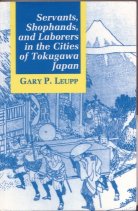
Servants, Shophands, and Laborers in the Cities of Tokugawa Japan

Although this book has a title which might lead a person to believe it would be incredibly boring, actually it's a very interesting book, especially when you consider that the events in the book transpired long before the United States became an actual country, independent from Britain.
Fortunately, the Tokugawa regime was efficient in keeping records and the records have allowed historians to reconstruct what life was life during that era for the average worker. One thing to keep in mind is that the government in that time wanted to keep things in the status quo and so people's status in life was pretty much locked in. You were very, very unlikely to start poor, "rise through the ranks" and then end up rich.
The Keian Edict, issued in 1649, "specified a regimen of ceaseless toil for this class" (the peasant class). It said that peasants had to rise early, cut grass, cultivate the fields during the day and make straw rope and bags in the evening. The husband was the field-worker; the wife was limited to working in the home, often at the loom. Even the type of food they could eat was written into the law, and they were not allowed to have tea, sake, tobacco or sightseeing.
The peasants were also limited to the geographical area they could travel and could be punished if they violated any of these rules.
The main problem was over the level of taxation which led to peasant revolts, with ten of them in the 1300's, over a hundred in the 1400's and a total of 2,700 during the entire Tokugawa reign.
It was a feudal system with the daimyo being the lords of the land. Even then were under particular controls, though. They could only have one castle; they couldn't seek to have anything to do with foreign trade and they couldn't build ships that could sail on the open seas.
The daimyo did not rebel until very late in the Tokugawa reign, though, but their lack of rebellion was made up for by the peasants. The entire structure of the society changed from one where there were, essentially, plantations and castles to where there were plantations, castles and quickly growing towns.
The workers in the towns were divided into artisans, servants and low-skilled manual laborers. There were also some slaves and some people basically working off tax obligations.
Over time there was a new class that arose, that of the middle-class level of merchants. In the social pecking order they were pretty much at the bottom, but over time they ended up gaining wealth if not status.
As retail shops, manufacturing facilities and entertainment facilities developed and grew more and more people found employment in them. There was also a servant group which was pretty similar to how servants in England were seen, covering a wide variety of household jobs. These positions included chamberlains, stewards, footboys, palanquin bearers, menial workers, parlormaids, wet nurses, nursemaids, seamstresses and scullery maids among others.
A typical "career history" would have a boy of eleven or so starting out at a dry goods store. He responsibilities were centered around keeping things cleaned and polished, running errands and slowly learning how to handle customers and keep track of sales on the abacus. Three years later he would be given an examination on his abilities to use the tools of the trade and, if found satisfactory, took a more active role in customer relations. Four years later he might get appointed "shopboy chief" and oversee younger boys in their work. At 17 or 18 years of age he would graduate to a level of handling receipts and expenditures. Eight years later he would be given a six month vacation. Upon returning, he would be promoted to salesman. He got another vacation after another six years then he could be appointed head clerk. When he got to be 45 or 46 years old he might be allowed to open up a branch shop and take a wife (with his master's approval).
Most workers, though, didn't rise that way and spent their lives at menial tasks.
Maidservants were expected to be able to do the laundry, cook, get well water, wash and do other activities. It was preferred, though, they they also be able to sing, play the shamisen and koto and be able to do hair and massage.
In other words, not a whole lot different from even today's world of working in retail shops and homes.
This was all centered around a master/underling relationship, reflected in Japanese schools in the senpai or elder student/young student relationship. You deferred to those older and in higher status than yourself and those with even lower status then you deferred to you. It wasn't exactly the same as the stereotyped master/slave relationship in the U.S. prior to the civil war.
That relationship could be duplicated, at times, but in general in Japan the "masters" were still expected to deal with their employees (underlings) in an acceptable manner. Servants were provided with lodging, meals and sometimes even education and training and once in a while even cash tips. There was even a sort of 401K program set up in some shops with money invested in a fund yearly for the worker. Getting the money if you left was not guaranteed, but it did happen more often then not.
Skilled workers were organized into guilds at least as early as the first part of the 1600's.
The entire book is filled with interesting information and shows that the Japanese world of the Tokugawa regime was not that terribly different from the Western world. The names were different, but the overall structures and concepts were pretty much the same.
This is a book that is worth reading.
Main Index
Japan main page
Japanese-American Internment Camps index page
Japan and World War II index page
|